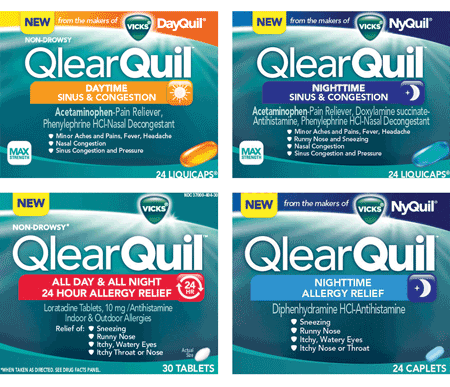QlearQuil Leverages Brand Into Allergy Space, Absorbs Existing ‘Quil’ Sinus Products
This article was originally published in The Tan Sheet
Executive Summary
P&G enters the OTC allergy category with QlearQuil products “for the occasional allergy sufferer.” But the firm also could be on the spot to prevent consumer confusion about indications for products in the broad selection with “Quil” in their brands.
Leveragingthe iconic “Quil” root of Procter & Gamble Co.’s OTC drug brands to drive interest in Vicks QlearQuil allergy and sinus products also could put the firm on the spot to prevent consumer confusion about indications for products in the broad selection.
P&G on Sept. 3 announced it is entering the OTC allergy category with the launch of QlearQuil products “for the occasional allergy sufferer.” The line also includes sinus products moved from other “Quil” lines and re-branded: DayQuil Sinex becomes QlearQuil Daytime Sinus & Congestion and NyQuil Sinex is QlearQuil Nighttime Sinus & Congestion, the firm says.
Patrick Lockwood-Taylor, a VP and general manager of P&G’s North America Personal Health Care business, says the line is “a range of trusted products that can treat symptoms day, night, or 24 hours.”
Day And Night Relief
The Vicks QlearQuil line includes:
- All Day & All Night 24 Hour Allergy Relief: loratadine 10mg
- Nighttime Sinus & Congestion Relief: acetaminophen 325mg, doxylamine succinate 6.25mg and phenylephrine HCI 5mg
- Daytime Sinus & Congestion Relief: acetaminophen 325mg and phenylephrine HCI 5mg
- Nighttime Allergy Relief: diphenhydramine hydrochloride 25mg
- 12 Hour Nasal Decongestant Moisturizing Spray: oxymetazoline HCI 0.5%.
The firm says around 50 million U.S. consumers, about one person in every four households, suffer from allergic rhinitis, or nasal allergies, but not all experience chronic allergies daily. P&G designed QlearQuil for consumers with occasional sinus and allergy symptoms and to allow individuals to customize their treatment based on symptoms.
“Occasional allergy sufferers often experience unpredictable symptoms that can vary by time of year, by week or even by day, which is where QlearQuil comes in,” says Lockwood-Taylor.
But use of the “Quil” brand-name root could be where consumer confusion comes in, too.
P&G is “going to have to work so that doesn’t cause confusion,” says brand positioning consultant Warren Ellish.
Ellish, president of Ellish Marketing Group in Denver, said advertising for QlearQuil should “make very clear in the consumer’s mind” how the product differs from others sharing the brand.
QlearQuil users and other consumers also could use NyQuil or DayQuil products for cold and flu symptoms, or ZzzQuil as an occasional sleep aid. Each of those products contains one or more of the ingredients in one or more of the QlearQuil line products:
- NyQuil, acetaminophen 650mg, dextromethorphan 30mg and doxylamine succinate 12.5mg
- DayQuil, acetaminophen 325mg and phenylephrine 5mg
- ZzzQuil, diphenhydramine 50mg.
P&G said it considered the potential for confusion among the “Quil” brands as it developed QlearQuil.
“P&G dedicated many resources and conducted consumer research prior to naming the new family of allergy and sinus mediations. P&G found QlearQuil was a unique name that both draws upon the strong heritage of the trusted Quils name and allows it to stand out in the category,” according to a spokesperson..
Additionally, label instructions are clear for all of the products. “As with any over-the-counter medication, consumers are advised to read the packaging to understand the indication for each product. It is also advised that consumers follow the dosing instructions listed on the product package and should not take more than directed,” the spokesperson said.
The firm declined to comment on marketing planned for the line, including whether advertising will emphasize that consumers carefully distinguish different “Quil” products.
Brand Confusion On FDA Radar
FDA is concerned about potential unintentional misuse of drugs linked to similar names among products with different indications.
In a May 2014 draft guidance on proprietary naming for all types of Rx and OTC drugs, the agency recommends drug sponsors conduct simulation studies with health care professionals and consumers to evaluate the safety of a proposed proprietary name for a drug product.

P&G’s QlearQuil line includes day and night sinus and congestion products, top, and allergy remedies, bottom.
The Center for Drug Evaluation and Research and the Center for Biologics Evaluation and Research state that if consumers “cannot readily distinguish among proprietary names that are similar phonetically (sound-alike names) or in their spelling or orthographic appearance (look-alike names), or are otherwise confusing or misleading, the patient might receive the wrong product or it might not be possible to correctly identify the product used.”
The draft guidance, the latest in a series of three intended to help minimize medication errors, cited a 1999 Institute of Medicine report which noted medication errors account for an estimated 7,000 deaths annually in the U.S. The first draft guidance focused on the design of drug products and the second on safety aspects of the container label and carton label design.
FDA also has warned OTC drug marketers about potentially confusing brand names.
After the agency in 2010 warned consumers not to swallow Johnson & Johnson’s Benadryl Extra Strength Itch Stopping Gel, the firm added "For Skin Use Only" to labeling for the product and launched consumer studies to identify other causes of confusion. FDA reported 121 adverse event reports linked to cases of mistaken ingestion of the gel between 2001 and 2009 and said consumers confused the topical product with Benadryl oral liquid products.
Also in 2010, Novartis Consumer Health agreed to change the name and packaging of its Maalox Total Relief stomachache/diarrhea remedy to avoid potential serious side effects if the product is confused with the antacids under the same brand. FDA warned of potential side effects such as digestive tract bleeding from bismuth subsalicylate, the active ingredient in Total Relief.
FDA that year published a guidance stating information it needs from manufacturers to evaluate proposed proprietary names to ensure the names do not look or sound like other drug names, which could cause medication errors. The 2010 guidance is for Rx drugs and OTCs approved through new drug applications, not for monograph OTCs; FDA pre-approval is not required for monograph product names.
FDA in 2009 initiated a pilot program to have industry conduct studies to evaluate potential flaws in brand names, but the agency has since noted limited industry participation, though the drug industry has said the pilot offers little incentive to participate (Also see "FDA’s Proposed Name Review Pilot Offers Little Reason To Participate" - Pink Sheet, 30 Jun, 2008.).
Branding That Differentiates
The flip side of the root of the QlearQuil brand name is strong differentiation from other similar products.
Ellish, who also is a visiting lecturer at the Cornell University Johnson Graduate School of Management, said P&G has established strong consumer loyalty to the brand, starting with the initial NyQuil liquid product, over other OTCs that contain the same ingredients and that might be available at a lower price.
“They took a product that isn’t substantially different from others and made it popular in the market,” he said. “In the minds of the consumer, they gave them a different way to use the product.”
While a consumer packaged goods brand could be stretched too thin with a wide variety of products bearing the same name, Ellish said P&G has maintained strong continuity among the “Quil” lines.
“Whenever you line extend, each line-extended product has to support the brand’s message to consumers. As long as there’s something about the brand that is consistent with each product in the line, your brand should remain strong with consumers.”
P&G recently announced plans to divest or discontinue half its brands and focus on lines that account for 90% of total sales. Vicks products and much of the rest of its OTC drug portfolio already were expected to be keepers for the firm, and the QlearQuil launch should buttress those expectations (Also see "P&G Likely To Keep Prilosec OTC, Vicks In Portfolio Shuffle – Analysts" - Pink Sheet, 28 Aug, 2014.).
